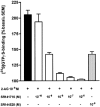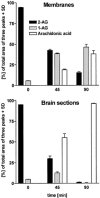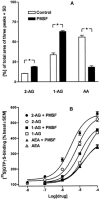Despite substantial degradation, 2-arachidonoylglycerol is a potent full efficacy agonist mediating CB(1) receptor-dependent G-protein activation in rat cerebellar membranes
- PMID: 11588122
- PMCID: PMC1572991
- DOI: 10.1038/sj.bjp.0704297
Despite substantial degradation, 2-arachidonoylglycerol is a potent full efficacy agonist mediating CB(1) receptor-dependent G-protein activation in rat cerebellar membranes
Abstract
1. Two endocannabinoids, arachidonoyl ethanolamide (AEA) and 2-arachidonoylglycerol (2-AG) bind and activate G-protein-coupled cannabinoid receptors, but limited data exist on their relative ability to activate G-proteins. 2. Here we assess agonist potency and efficacy of various cannabinoids, including 2-AG, HU-310 (2-arachidonoyl glyceryl ether, a third putative endocannabinoid), HU-313 (another ether analogue of 2-AG), AEA, R-methanandamide (an enzymatically stable analogue of AEA), and CP-55,940 at rat brain CB(1) receptors using agonist-stimulated [(35)S]-GTPgammaS binding to cerebellar membranes and whole brain sections. Degradation of endocannabinoids under experimental conditions was monitored by HPLC. 3. To enhance efficacy differences, agonist dose-response curves were generated using increasing GDP concentrations. At 10(-6) M GDP, all compounds, except HU-313, produced full agonists responses approximately 2.5 fold over basal. The superior efficacy of 2-AG over all other compounds became evident by increasing GDP (10(-5) and 10(-4) M). 4. In membrane incubations, 2-AG was degraded by 85% whereas AEA and HU-310 were stable. Pretreatment of membranes with phenylmethylsulphonyl fluoride inhibited 2-AG degradation, resulting in 2 fold increase in agonist potency. Such pretreatment had no effect on AEA potency. 5. Responses in brain sections were otherwise consistent with membrane binding data, but 2-AG evoked only a weak signal in brain sections, apparently due to more extensive degradation. 6. These data establish that even under conditions of substantial degradation, 2-AG is a full efficacy agonist, clearly more potent than AEA, in mediating CB(1) receptor-dependent G-protein activity in native membranes.
Figures





Similar articles
-
Oxygenated metabolites of anandamide and 2-arachidonoylglycerol: conformational analysis and interaction with cannabinoid receptors, membrane transporter, and fatty acid amide hydrolase.J Med Chem. 2002 Aug 15;45(17):3709-20. doi: 10.1021/jm020818q. J Med Chem. 2002. PMID: 12166944
-
Endocannabinoid 2-arachidonyl glycerol is a full agonist through human type 2 cannabinoid receptor: antagonism by anandamide.Mol Pharmacol. 2000 May;57(5):1045-50. Mol Pharmacol. 2000. PMID: 10779390
-
Brain regional distribution of endocannabinoids: implications for their biosynthesis and biological function.Biochem Biophys Res Commun. 1999 Mar 16;256(2):377-80. doi: 10.1006/bbrc.1999.0254. Biochem Biophys Res Commun. 1999. PMID: 10079192
-
Biochemistry and pharmacology of the endocannabinoids arachidonylethanolamide and 2-arachidonylglycerol.Prostaglandins Other Lipid Mediat. 2000 Apr;61(1-2):3-18. doi: 10.1016/s0090-6980(00)00051-4. Prostaglandins Other Lipid Mediat. 2000. PMID: 10785538 Review.
-
Cannabinoid receptors and their ligands.Prostaglandins Leukot Essent Fatty Acids. 2002 Feb-Mar;66(2-3):101-21. doi: 10.1054/plef.2001.0341. Prostaglandins Leukot Essent Fatty Acids. 2002. PMID: 12052030 Review.
Cited by
-
Role of the endogenous cannabinoid system in nicotine addiction: novel insights.Front Psychiatry. 2015 Mar 25;6:41. doi: 10.3389/fpsyt.2015.00041. eCollection 2015. Front Psychiatry. 2015. PMID: 25859226 Free PMC article. Review.
-
Approaches to Assess Functional Selectivity in GPCRs: Evaluating G Protein Signaling in an Endogenous Environment.Methods Mol Biol. 2015;1335:177-89. doi: 10.1007/978-1-4939-2914-6_12. Methods Mol Biol. 2015. PMID: 26260601 Free PMC article.
-
2-arachidonoylglycerol, an endogenous cannabinoid receptor ligand, induces rapid actin polymerization in HL-60 cells differentiated into macrophage-like cells.Biochem J. 2005 Mar 15;386(Pt 3):583-9. doi: 10.1042/BJ20041163. Biochem J. 2005. PMID: 15456404 Free PMC article.
-
Circulating Endocannabinoids in Canine Multicentric Lymphoma Patients.Front Vet Sci. 2022 Feb 15;9:828095. doi: 10.3389/fvets.2022.828095. eCollection 2022. Front Vet Sci. 2022. PMID: 35242839 Free PMC article.
-
Fatty acid amide signaling molecules.Bioorg Med Chem Lett. 2010 Oct 15;20(20):5959-68. doi: 10.1016/j.bmcl.2010.08.048. Epub 2010 Aug 13. Bioorg Med Chem Lett. 2010. PMID: 20817522 Free PMC article. Review.
References
-
- BRADFORD M.M. A rapid and sensitive method for the quantitation of microgram quantities of protein utilizing the principle of protein-dye binding. Anal. Biochem. 1976;72:248–254. - PubMed
-
- BREIVOGEL C.S., CHILDERS S.R. Cannabinoid agonist signal transduction in rat brain: comparison of cannabinoid agonists in receptor binding, G-protein activation, and adenylyl cyclase inhibition. J. Pharmacol. Exp. Ther. 2000;295:328–336. - PubMed
-
- BREIVOGEL C.S., SELLEY D.S., CHILDERS S.R. Cannabinoid receptor agonist efficacy for stimulating [35S]-GTPγS binding to rat cerebellar membranes correlates with agonist-induced decreases in GDP affinity. J. Biol. Chem. 1998;273:16865–16873. - PubMed
-
- DEVANE W.A., HANUS L., BREUER A., PERTWEE R.G., STEVENSON L.A., GRIFFIN G., GIBSON D., MANDELBAUM A., ETINGER A., MECHOULAM R. Isolation and structure of a brain constituent that binds to the cannabinoid receptor. Science. 1992;258:1946–1949. - PubMed
Publication types
MeSH terms
Substances
LinkOut - more resources
Full Text Sources
Other Literature Sources
Miscellaneous

